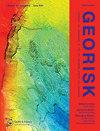西班牙大西洋海啸预警系统的超实时(FTRT)海啸模拟分析
IF 4.8
3区 工程技术
Q1 ENGINEERING, GEOLOGICAL
Georisk-Assessment and Management of Risk for Engineered Systems and Geohazards
Pub Date : 2022-07-01
DOI:10.3390/geohazards3030019
引用次数: 1
摘要
实时本地海啸预警体现了海啸发生后最初几分钟内源定义中未知因素的不确定性。一般来说,海啸预警系统(TWS)通过对单个事件的确定性模拟,提供对海啸作用的快速估计。在本研究中,通过运行135次海啸模拟,纳入了海啸震源参数的变化;除此之外,还考虑了大西洋东北部的四个不同的计算域,得出了与单个事件相关的540次模拟。这是针对加的斯湾地震引发的海啸所做的研究,海啸影响了伊比利亚半岛西部和加那利群岛。1分钟后给出第一个答案,完成四个计算域的所有模拟需要7分钟。快速的计算使得沿海岸的警报级别被纳入西班牙国家海啸预警系统。主要发现是,在某些沿海地区,使用一组考虑到震源参数不确定性的情景可以产生比单一确定性参考情景更高的海啸警报。因此,本研究表明,考虑海啸震源参数的不确定性有助于避免可能的海啸预警级别低估。此外,本研究表明,在使用高性能计算资源的实际TWS中,这是可以实时完成的。本文章由计算机程序翻译,如有差异,请以英文原文为准。
Analysis of Faster-Than-Real-Time (FTRT) Tsunami Simulations for the Spanish Tsunami Warning System for the Atlantic
Real-time local tsunami warnings embody uncertainty from unknowns in the source definition within the first minutes after the tsunami generates. In general, Tsunami Warning Systems (TWS) provide a quick estimate for tsunami action from deterministic simulations of a single event. In this study, variability in tsunami source parameters has been included by running 135 tsunami simulations; besides this, four different computational domains in the northeastern Atlantic ocean have been considered, resulting in 540 simulations associated with a single event. This was done for tsunamis generated by earthquakes in the Gulf of Cadiz with impact in the western Iberian peninsula and the Canary Islands. A first answer is provided after one minute, and 7 min are required to perform all the simulations in the four computational domains. The fast computation allows alert levels all along the coast to be incorporated into the Spanish National Tsunami Early Warning System. The main findings are that the use of a set of scenarios that account for the uncertainty in source parameters can produce higher tsunami warnings in certain coastal areas than those obtained from a single deterministic reference scenario. Therefore, this work shows that considering uncertainties in tsunami source parameters helps to avoid possible tsunami warning level underestimations. Furthermore, this study demonstrates that this is possible to do in real time in an actual TWS with the use of high-performance computing resources.
求助全文
通过发布文献求助,成功后即可免费获取论文全文。
去求助
来源期刊
CiteScore
8.70
自引率
10.40%
发文量
31
期刊介绍:
Georisk covers many diversified but interlinked areas of active research and practice, such as geohazards (earthquakes, landslides, avalanches, rockfalls, tsunamis, etc.), safety of engineered systems (dams, buildings, offshore structures, lifelines, etc.), environmental risk, seismic risk, reliability-based design and code calibration, geostatistics, decision analyses, structural reliability, maintenance and life cycle performance, risk and vulnerability, hazard mapping, loss assessment (economic, social, environmental, etc.), GIS databases, remote sensing, and many other related disciplines. The underlying theme is that uncertainties associated with geomaterials (soils, rocks), geologic processes, and possible subsequent treatments, are usually large and complex and these uncertainties play an indispensable role in the risk assessment and management of engineered and natural systems. Significant theoretical and practical challenges remain on quantifying these uncertainties and developing defensible risk management methodologies that are acceptable to decision makers and stakeholders. Many opportunities to leverage on the rapid advancement in Bayesian analysis, machine learning, artificial intelligence, and other data-driven methods also exist, which can greatly enhance our decision-making abilities. The basic goal of this international peer-reviewed journal is to provide a multi-disciplinary scientific forum for cross fertilization of ideas between interested parties working on various aspects of georisk to advance the state-of-the-art and the state-of-the-practice.

 求助内容:
求助内容: 应助结果提醒方式:
应助结果提醒方式:


